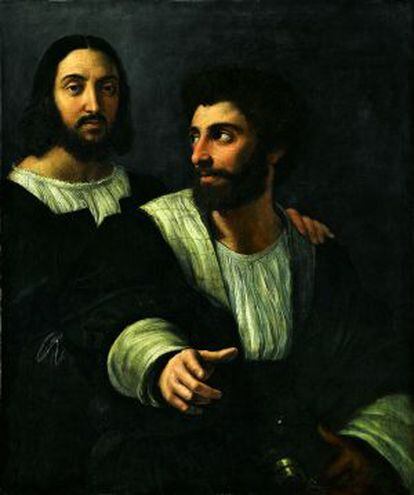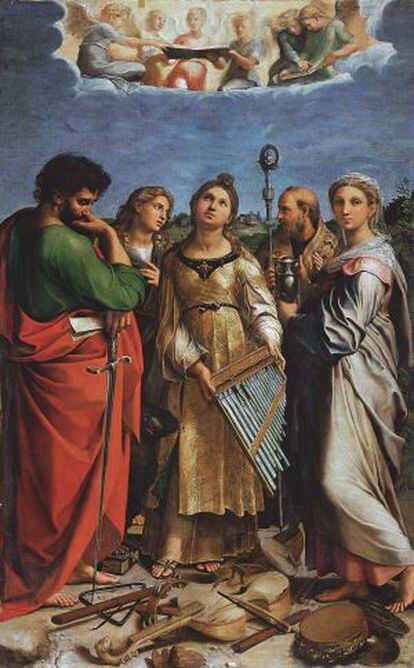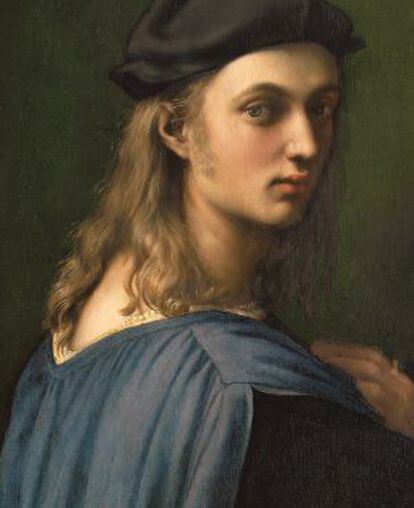Portrait of an ardent genius
Five years in the making, the Prado Museum’s big summer show focuses on the under-explored late career of the great Renaissance painter, Raphael

Misfortune generally makes for a better story than happiness, except when the happy tale ends abruptly and unfairly. Raphael’s life was filled with joy and success, but it was far too short. Still, it was long enough for his art to be considered unsurpassable even now, nearly five centuries after his death.
He died at age 37 in Rome, his adopted home, for reasons that rank among the most peculiar in the history of Western culture. Legend has it that he and his lover, La Fornarina, took their sexual pleasure so far that one day he collapsed from exhaustion and required medical attention. A mistake by his doctors finished him off, according to reports from the time, and after lying in bed with a raging fever for several days, he died on Good Friday of 1520 (the same day on which he was born in 1483). Rome was awash with tears over the loss of its best painter, its most refined and sensual intellectual, its champion of inventiveness, its sharp recorder of the Renaissance dream.
Even inexplicable phenomena seemed to take his side. Shortly after his death, a crack opened up at the Vatican palace in apparent response to the sorrowful event, as recounted by Antonio Forcellino in his book Raphael: A Happy Life. The truth is, Raphael might have died of malaria or even from lead poisoning caused by the paints he used. But who needs an empirical explanation when you have such a rich legend?
Be that as it may, his death in a way marked the beginning of the end of Renaissance splendor in Rome. The Florentine painter had moved there at age 25, attracted by the big city’s promise of sensual pleasures and its recently discovered antiquity. He was preceded by his own fame as a charmer and as an artist of outstanding talent after taking over his deceased father’s workshop in Urbino.
The show is as much about the artist’s workshop as it is about him
He came to the Eternal City on the request of Pope Julius II. Rome was anxious to shake off the ignominy brought upon the city by Spanish pontiff Alexander VI, and this was the right place and the right time for an ambitious young man like Raphael.
Working under Julius II and his successor, Leo X, the artist helped craft the tale of an era that partly ended with his own death, and finished completely with the Sack of Rome by Imperialist troops in 1527. “When the Lutheran soldiers marched in, it signaled a symbolic end to the Renaissance,” explains Miguel Falomir, the Prado’s top expert in Italian painting before 1700.
Now, the Prado is partnering with the Louvre to present Late Raphael, an exhibition of 40 paintings and 30 drawings that encapsulate that incomparable period. Besides representing a unique chance to view a large amount of artistic wonders from two of the best Raphael collections in the world (alongside a few major loans), the show features an added bonus: it focuses on the last period of Raphael’s life, which has been less explored than his earlier years.
It is also an oft-derided period of the artist’s career. In the 19th century, Italian and German academics, as well as the Pre-Raphaelites, recovered Raphael’s work but misconstrued the true meaning of his constantly evolving creativity, and viewed his Roman years as a betrayal of his early ideals. And why is that? Precisely for the same reason celebrated by the show’s curators, Tom Henry and Paul Joannides, two of the world’s top Raphael specialists (Miguel Falomir and Vincent Delieuvin, the Renaissance curators at the Prado and Louvre handed them the baton). In fact, the show is as much about the artist’s workshop as it is about him. A veritable factory powered by 50 workers, the studio was astutely managed by Raphael and under his guidance it soon became a well-oiled machine that churned out commissioned work designed by himself but executed by employees who were more than mere apprentices, especially in the cases of Giulio Romano and Giovanni Francesco Penni.
Raphael was ready to compete against anyone, be it Da Vinci or Michelangelo
Five years of work have gone into this exhibition, and the show catalogue aims to become a reference for future Raphael studies. The list includes a few attributions that will give academics food for debate and also provides an interesting reflection on the idea of authorship by focusing on quality rather than just a signature on a canvas. The show ends with works completed after Raphael’s death in a section filled with paintings inspired by The Transfiguration, here present in the form of a Prado-owned copy that was completed between 1520 and 1528 by the workshop of Romano and Penni. The original, which is kept in the Vatican museum and considered one of Raphael’s best works, cannot travel.
“It is an exhibition about the way Raphael’s mind worked and about the precise instructions he gave for others to finish his work, of which we preserve valuable information in the drawings and preliminary sketches,” says the co-curator Tom Henry. The reason why Raphael ceded so much of the limelight to his collaborators has a lot to do with the way workshops functioned at the time (they clearly had little to do with the Romantic notion of a solitary artist struggling with his work from beginning to end). Besides that, the genius from Urbino was notably incapable of turning down a commission.
For the Vatican, the workshop painted, among other things, four enormous rooms with designs of steadily increasing technical complexity and artistic emotion. Raphael was well aware to whom he owed allegiance, as the depictions of his patrons (and of himself) in the rooms’ frescos makes clear.
He arrived at the Vatican on the recommendation of a distant relative, the architect Donato Bramante. The original idea was for him to participate with others in the decoration of Julius II’s library. But when the latter saw of what Raphael was capable, he sent everyone else home and entrusted him with the entire project. Julius II was an unpredictable pontiff whose main goal, besides military conquest, was to eliminate all memory of his predecessor. The pope clearly understood that art could be a phenomenal vehicle for propaganda, and he viewed Raphael’s incredible skills as a moral victory over the nefarious Alexander VI, who had his apartments decorated by the more modest Pinturicchio.

One of the most disturbing paintings by Raphael continues to be the portrait of Julius II, which he made in 1512 and is kept at the National Gallery in London. It depicts the pontiff with a long beard, the result of an oath he took: he would not shave until he defeated the Ferrara army and threw out the French invaders. His eyes have the melancholy look of defeat, but the pope, whose bellicose attitude had been reprimanded by the likes of Erasmus of Rotterdam, also had the peaceful aura of one with a profound spiritual life. When Julius II died in 1513, his successor Leo X, who was more given to earthly pleasures and hunting parties than battles, did not see the need to change the artistic and financial status quo. But perhaps that was because Agostino Chigi, a banker from Siena and Raphael’s favorite employer, immediately extended Leo X a loan of 75,000 ducats as a welcome gesture.
It was for Chigi that Raphael painted one of his best frescos: the Loggia di Psiche, in Villa Farnesina. With Baroque music playing in the background and a spring sun flooding a covered terrace in Rome, Gabriele Finaldi, the deputy director of the Prado Museum, recently recounted some of Chigi’s eccentricities to illustrate the easygoing atmosphere that marked Raphael’s golden years: “They say that meals were eaten on golden plates that were later tossed into the Tiber. Apparently, the dining set was always recovered afterwards with a fishing net that had been previously cast at the bottom of the river,” he says.
That was not the only excess witnessed by these walls. Giorgio Vasari, a painter and architect who became famous as the world’s first art historian, wrote in a 1550 treatise that Chigi was forced to provide Raphael with a bed so the artist could complete a commission while also satisfying his sexual impulses. Two paintings stand above the rest in his endless search for the female ideal: Portrait of a Woman, in Florence, and La Fornarina, kept at the Barberini Palace in Rome.
Solving Raphael’s sex-related needs was not the only way to get him to work. Another trick that always worked was to constantly compare him to his artistic enemies (this was in fact a popular practice among art patrons of that period). While he was decorating La Farnesina and working on his last painting, The Transfiguration, he was constantly pitted against Sebastiano del Piombo. True, Del Piombo never did seem to be at the same level as his mentor, Michelangelo. But there is a famous anecdote about how Raphael changed the way he made the frescoes in the Vatican apartments when he was spirited into the Sistine Chapel and furtively allowed to view the unfinished work by his archrival. Raphael was always ready to compete against anyone, be it Leonardo da Vinci or Michelangelo.
“He felt panic at the idea of becoming obsolete ever since he witnessed Perugino, with whom he trained, go from being considered a great painter to being condemned to irrelevance,” explains the scholar Falomir.

Guided by that revelation, Raphael worked tirelessly until he was alone at the top. Towards 1514, Michelangelo — who was isolated by his own unruly temperament — was immersed in one of his titanic sculptural projects. And Leonardo was by then an old man and overtaken by his own scientific obsessions. It was then that Raphael was asked to succeed the recently deceased Bramante as the head of antiquities in Rome, a position that gave free rein to his other great passion, archeology.
There followed enormously busy years in which Raphael sketched out ideas and others completed them. According to Tom Henry, during this period the only paintings that are 100-percent for sure made by him are those he made of his friends and benefactors. Among these, three stand out: the portraits of Baldassarre Castiglione (1519), his self-portrait with Giulio Romano and the portrait of Bindo Altoviti (1516-1518). These and other artworks make you wonder what else might have come from Raphael’s paintbrush if he hadn’t succumbed to his own legend at such a young age. Even Henry, whose “positive Anglo-Saxon thought,” does not allow him to venture into the realm of art-fiction, believes if he hadn’t died, the evolution of Western art would have saved itself around 80 years.
El último Rafael. Until September 16 at the Prado Museum, Madrid.











































